Charlie Hebdo
|
| |
| Type | Satirical weekly news magazine |
|---|---|
| Format | Berliner |
| Editor | Gérard Biard |
| Founded | 1970[1] |
| Political alignment | Left-wing |
| Ceased publication | 1981 |
| Relaunched | 1992 |
| Headquarters | Paris, France |
| ISSN | 1240-0068 |
| Website |
www |
Charlie Hebdo (French pronunciation: [ʃaʁli ɛbdo]; French for Charlie Weekly) is a French satirical weekly magazine,[2] featuring cartoons,[3] reports, polemics, and jokes. Irreverent and stridently non-conformist in tone, the publication describes itself as above all secular, skeptic,[4] and atheist,[5] far-left-wing,[6][7] and anti-racist[8] publishing articles about the extreme right (especially the French nationalist National Front party),[9] religion (Catholicism, Islam, Judaism), politics and culture.
The magazine has been the target of two terrorist attacks, in 2011 and 2015. Both were presumed to be in response to a number of controversial Muhammad cartoons it published. In the second of these attacks, 12 people were killed, including publishing director Charb and several other prominent cartoonists.
Charlie Hebdo first appeared in 1970 as a companion to the monthly Hara-Kiri magazine, after a previous title was banned for mocking the death of former French President Charles de Gaulle.[10] In 1981 publication ceased, but the magazine was resurrected in 1992. Its current editor-in-chief is Gérard Biard. The previous editors were François Cavanna (1970–1981) and Philippe Val (1992–2009). The magazine is published every Wednesday, with special editions issued on an unscheduled basis.
Origins in Hara-Kiri
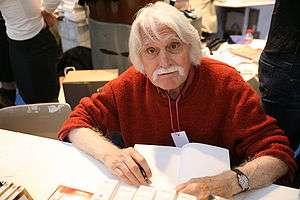
In 1960, Georges "Professeur Choron" Bernier and François Cavanna launched a monthly magazine entitled Hara-Kiri.[11] Choron acted as the director of publication and Cavanna as its editor. Eventually Cavanna gathered together a team which included Roland Topor, Fred, Jean-Marc Reiser, Georges Wolinski, Gébé, and Cabu. After an early reader's letter accused them of being "dumb and nasty" ("bête et méchant"), the phrase became an official slogan for the magazine and made it into everyday language in France.
Hara-Kiri was briefly banned in 1961, and again for six months in 1966. A few contributors did not return along with the newspaper, such as Gébé, Cabu, Topor, and Fred. New members of the team included Delfeil de Ton, Pierre Fournier (journaliste), and Willem.
In 1969, the Hara-Kiri team decided to produce a weekly publication – on top of the existing monthly magazine – which would focus more on current affairs. This was launched in February as Hara-Kiri Hebdo and renamed L'Hebdo Hara-Kiri in May of the same year.[12] (Hebdo is short for hebdomadaire – "weekly")
In November 1970, the former French president Charles de Gaulle died in his home village of Colombey-les-Deux-Églises, eight days after a disaster in a nightclub, the Club Cinq-Sept fire, which caused the death of 146 people. The magazine released a cover spoofing the popular press's coverage of this disaster, headlined "Tragic Ball at Colombey, one dead."[11] As a result, the weekly was banned.
In order to sidestep the ban, the editorial team decided to change its title, and used Charlie Hebdo.[1] The new name was derived from a monthly comics magazine called Charlie (later renamed Charlie Mensuel, meaning Charlie Monthly), which had been started by Bernier and Delfeil de Ton in 1969. The monthly Charlie took its name from the lead character of one of the comics it originally published, Peanuts's Charlie Brown. Using that title for the new weekly magazine was also an inside joke about Charles de Gaulle.[13][14][15] The first issue did feature a Peanuts strip, as the editors were fans of the series.[16]
In December 1981, publication ceased.[17]
Rebirth
In 1991, Gébé, Cabu and others were reunited to work for La Grosse Bertha, a new weekly magazine resembling Charlie Hebdo created in reaction to the First Gulf War and edited by singer and comedian Philippe Val. However, the following year, Val clashed with the publisher, who wanted apolitical humour, and was fired. Gébé and Cabu walked out with him and decided to launch their own paper again. The three called upon Cavanna, Delfeil de Ton and Wolinski, requesting their help and input. After much searching for a new name, the obvious idea of resurrecting Charlie Hebdo was agreed on. The new magazine was owned by Val, Gébé, Cabu and singer Renaud. Val was editor, Gébé publication director.
The publication of the new Charlie Hebdo began in July 1992 amidst much publicity. The first issue under the new publication sold 100,000 copies. Choron, who had fallen out with his former colleagues, tried to restart a weekly Hara-Kiri, but its publication was short-lived. Choron died in January 2005.
On 26 April 1996, François Cavanna, Charb and Philippe Val filed 173,704 signatures, obtained in eight months, with the aim of banning the political party Front National, since it would have contravened the articles 1, 2, 4, 6 and 7 of the Declaration of the Rights of Man and of the Citizen.[18]
In 2000, journalist Mona Chollet was sacked after she had protested against a Philippe Val article which called Palestinians "non-civilised".[19] In 2004, following the death of Gébé, Val succeeded him as director of publication, while still holding his position as editor.[20]
In 2008, controversy broke over a column by veteran cartoonist Siné which led to accusations of antisemitism and Siné's sacking by Val. Siné successfully sued the newspaper for unfair dismissal and Charlie Hebdo was ordered to pay him €90,000 in damages.[21] Siné launched a rival paper called Siné Hebdo which later became Siné Mensuel. Charlie Hebdo launched its Internet site, after years of reluctance from Val. In 2009, Philippe Val resigned after being appointed director of France Inter, a public radio station to which he has contributed since the early 1990s. His functions were split between two cartoonists, Charb and Riss. Val gave away his shares in 2011. As of March 2011, Charlie Hebdo was owned by Charb (600 shares), Riss (599 shares), finance director Éric Portheault (299 shares), and Cabu and Bernard Maris with one share each.[22]
Gérard Biard is the editor-in-chief of Charlie Hebdo.[23]
On 5 May 2015 Charlie Hebdo was awarded the PEN/Toni and James C. Goodale Freedom of Expression Courage Award at the PEN American Center Literary Gala in New York City.[24]
Legal issues
Mosque of Paris v Val (2007)
In 2007 the Grand Mosque of Paris began criminal proceedings against the chief-editor of Charlie Hebdo, Philipe Val, under France's hate speech laws for publicly abusing a group on the ground of their religion. The lawsuit was limited to three specific cartoons, including one depicting Muhammad carrying a bomb in his turban. In March 2007 le tribunal de Paris acquitted Val, finding that it was fundamentalists, rather than Muslims, who were being ridiculed in the cartoons.[25]
Siné sacking (2008)
On 2 July 2008, a column by the cartoonist Siné (Maurice Sinet) appeared in Charlie Hebdo citing a rumour that Jean Sarkozy, son of Nicolas Sarkozy, had announced his intention to convert to Judaism before marrying his fiancée, a Jewish heiress Jessica Sebaoun-Darty. Siné added, "he'll go far, this lad!"[26] This led to complaints of anti-Semitism. The magazine's editor, Philippe Val, ordered Siné to write a letter of apology or face termination. The cartoonist said he would rather "cut his own balls off," and was promptly fired. Both sides subsequently filed lawsuits, and in December 2010, Siné won a 40,000 euros court judgment against his former publisher for wrongful termination.[27]
Muhammad cartoons and aftermath
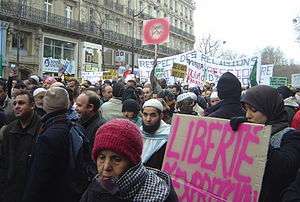
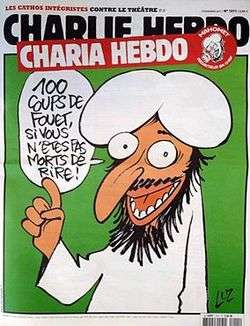
2006 publication
Controversy arose over the publication's edition of 9 February 2006. Under the title "Mahomet débordé par les intégristes" ("Muhammad overwhelmed by fundamentalists"), the front page showed a cartoon of a weeping Muhammad saying "C'est dur d'être aimé par des cons" ("it's hard being loved by jerks"). The newspaper reprinted the twelve cartoons of the Jyllands-Posten Muhammad cartoons controversy and added some of their own. Compared to a regular circulation of 100,000 sold copies, this edition enjoyed great commercial success. 160,000 copies were sold and another 150,000 were in print later that day.
In response, French President Jacques Chirac condemned "overt provocations" which could inflame passions. "Anything that can hurt the convictions of someone else, in particular religious convictions, should be avoided", Chirac said. The Grand Mosque of Paris, the Muslim World League and the Union of French Islamic Organisations (UOIF) sued, claiming the cartoon edition included racist cartoons.[28] A later edition contained a statement by a group of twelve writers warning against Islamism.[29]
The suit by the Grand Mosque and the UOIF reached the courts in February 2007. Publisher Philippe Val contended "It is racist to imagine that they can't understand a joke," but Francis Szpiner, the lawyer for the Grand Mosque, explained the suit: "Two of those caricatures make a link between Muslims and Muslim terrorists. That has a name and it's called racism."[30]
Future president Nicolas Sarkozy sent a letter to be read in court expressing his support for the ancient French tradition of satire.[31] François Bayrou and future president François Hollande also expressed their support for freedom of expression. The French Council of the Muslim Faith (CFCM) criticised the expression of these sentiments, claiming that they were politicising a court case.[32]
On 22 March 2007, executive editor Val was acquitted by the court.[33] The court followed the state attorney's reasoning that two of the three cartoons were not an attack on Islam, but on Muslim terrorists, and that the third cartoon with Muhammad with a bomb in his turban should be seen in the context of the magazine in question, which attacked religious fundamentalism.[34]
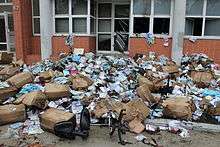
November 2011 firebombing
In November 2011, the newspaper's office in the 20th arrondissement[35][36] was fire-bombed and its website hacked. The attacks were presumed to be linked to its decision to rename the edition of 3 November 2011 "Charia Hebdo", with Muhammad listed as the "editor-in-chief".[37] The cover, featuring a cartoon of Muhammad saying: "100 lashes of the whip if you don't die laughing" by Luz (Rénald Luzier), had circulated on social media for a couple of days.
The "Charia Hebdo" issue had been a response to recent news of the post-election introduction of sharia law in Libya and the victory of the Islamist party in Tunisia.[38] It especially focuses on oppression of women under sharia, taking aim at domestic violence, mandatory veiling, burquas, restrictions on freedom, forced marriage, and stoning of those accused of adultery. It also targeted oppression of gays and dissenters, and practices such as stoning, flogging, hand/foot/tongue amputations, polygamy, forced marriage, and early indoctrination of children. "Guest editor" Muhammad is portrayed as a good-humoured voice of reason, decrying the recent elections and calling for a separation between politics and religion, while stating that Islam is compatible with humour.[39] The magazine responded to the bombing by distributing some four times the usual number of copies.[40]
Charb was quoted by Associated Press stating that the attack might have been carried out by "stupid people who don't know what Islam is" and that they are "idiots who betray their own religion". Mohammed Moussaoui, head of the French Council of the Muslim Faith, said his organisation deplores "the very mocking tone of the paper toward Islam and its prophet but reaffirms with force its total opposition to all acts and all forms of violence."[41] François Fillon, the prime minister, and Claude Guéant, the interior minister, voiced support for Charlie Hebdo,[36] as did feminist writer Ayaan Hirsi Ali, who criticised calls for self-censorship.[42]
2012 cartoons depicting Muhammad
In September 2012, the newspaper published a series of satirical cartoons of Muhammad, some of which featured nude caricatures of him.[43][44] Given that this issue came days after a series of attacks on US embassies in the Middle East, purportedly in response to the anti-Islamic film Innocence of Muslims, the French government decided to increase security at certain French embassies, as well as to close the French embassies, consulates, cultural centres, and international schools in about 20 Muslim countries.[45] In addition, riot police surrounded the offices of the magazine to protect it against possible attacks.[44][46][47]
Foreign Minister Laurent Fabius criticised the magazine's decision, saying, "In France, there is a principle of freedom of expression, which should not be undermined. In the present context, given this absurd video that has been aired, strong emotions have been awakened in many Muslim countries. Is it really sensible or intelligent to pour oil on the fire?"[48] The US White House said "a French magazine published cartoons featuring a figure resembling the Prophet Muhammad, and obviously, we have questions about the judgment of publishing something like this."[49] However, the newspaper's editor defended publication of the cartoons, saying, "We do caricatures of everyone, and above all every week, and when we do it with the Prophet, it's called provocation."[50][51]
2015 attack
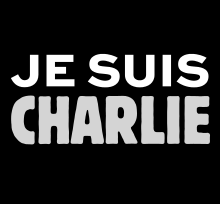

On 7 January 2015, two Islamist gunmen[52] forced their way into the Paris headquarters of Charlie Hebdo and opened fire, killing twelve: staff cartoonists Charb, Cabu, Honoré, Tignous and Wolinski,[53] economist Bernard Maris, editors Elsa Cayat and Mustapha Ourrad, guest Michel Renaud, maintenance worker Frédéric Boisseau and police officers Brinsolaro and Merabet, and wounding eleven, four of them seriously.[54][55][56][57][58][59]
During the attack, the gunmen shouted "Allahu akbar" ("God is great" in Arabic) and also "the Prophet is avenged".[52][60] President François Hollande described it as a "terrorist attack of the most extreme barbarity".[61] The two gunmen were identified as Saïd Kouachi and Chérif Kouachi, French Muslim brothers of Algerian descent.[62][63][64][65][66]
The "survivors' issue"
The day after the attack, the remaining staff of Charlie Hebdo announced that publication would continue, with the following week's edition of the newspaper to be published according to the usual schedule with a print run of one million copies, up significantly from its usual 60,000.[67][68] On 13 January 2015, the news came on BBC that the first issue after the massacre will come out in three million copies.[69] On Wednesday itself it was announced that with a huge demand in France, the print run would be raised from three to five million copies.[70] The newspaper announced the revenue from the issue would go towards the families of the victims.[71]
The French government granted nearly €1 million to support the magazine.[72] The Digital Innovation Press Fund (French: Fonds Google–AIPG pour l’Innovation Numérique de la presse), partially funded by Google, donated €250,000,[73] matching a donation by the French Press and Pluralism Fund.[74] The Guardian Media Group pledged a donation of £100,000.[75]
Je suis Charlie

After the attacks, the phrase Je suis Charlie, French for "I am Charlie", was adopted by supporters of free speech and freedom of expression who were reacting to the shootings. The phrase identifies a speaker or supporter of those who were killed at the Charlie Hebdo shooting, and by extension, a supporter of freedom of speech and resistance to armed threats. Some journalists embraced the expression as a rallying cry for the freedom of self-expression.[77]
The slogan was first used on Twitter and spread to the Internet at large. The Twitter account and the original "Je suis Charlie" picture bearing the phrase in white Charlie Hebdo style font on black background were created by French journalist and artist Joachim Roncin just after the massacre.[78]
The website of Charlie Hebdo went offline shortly after the shooting, and when it returned it bore the legend Je Suis Charlie on a black background.[79] The statement was used as the hashtag #jesuischarlie on Twitter,[80] as computer-printed or hand-made placards and stickers, and displayed on mobile phones at vigils, and on many websites, particularly media sites. While other symbols were used, notably holding pens in the air, the phrase "Not Afraid", and tweeting certain images, "Je Suis Charlie" became more widespread.[81]
Republican marches
A series of rallies took place in cities across France on 10–11 January 2015 to honour the victims of the Charlie Hebdo shooting, and also to voice support for freedom of speech.[82]
Luz, one of the survivors of the attack, stated: "People sang La Marseillaise. We're speaking about the memory of Charb, Tignous, Cabu, Honoré, Wolinski: they would all have abhorred that kind of attitude."[83] Willem, another surviving cartoonist, declared that "We vomit on those who suddenly declared that they were our friends".[84]
Other reactions
Unrest in Niger following the publication of the post-attack issue of Charlie Hebdo resulted in ten deaths,[85] dozens injured, and at least nine churches burned.[86] The Guardian reported seven churches burned in Niamey alone. Churches were also reported to be on fire in eastern Maradi and Goure. Violent demonstrations also were prevalent in Zinder, where some burned French flags. There were violent demonstrations in Karachi in Pakistan, where Asif Hassan, a photographer working for the Agence France-Presse, was seriously injured by a shot to the chest. In Algiers and Jordan, protesters clashed with police, while peaceful demonstrations were held in Khartoum, Sudan, Russia, Mali, Senegal, and Mauritania.[86]
RT reported that a million people attended a demonstration in Grozny, the capital city of the Chechen Republic, protesting against the depictions of Muhammad in Charlie Hebdo and proclaiming that Islam is a religion of peace. One of the slogans was "Violence is not the method".[87] Chechen leader Ramzan Kadyrov declared a regional holiday and denounced “people without spiritual and moral values” in front of an audience estimated to range between 600,000 and a million people.[88]
A British NGO, the Islamic Human Rights Commission, gave their 2015 international 'Islamophobe of the Year' award to Charlie Hebdo,[89] whereas another British organisation, the National Secular Society, awarded the Charlie Hebdo staff with Secularist of the Year 2015 "for their courageous response to the terror attack". The magazine said it would donate the associated £5,000 prize money to the fund that supports the families of the murdered cartoonists.[90]
Post-attack
.jpg)
Following some controversies over the paper's future following the 2015 attack,[91] Charb's 40% stake in Charlie Hebdo was purchased from his parents by Riss and Eric Portheault, who were as of July 2015 sole shareholders in the paper. Charlie Hebdo switched to a new legal press publisher status which requires 70% of profits to be reinvested.[92]
Other controversies
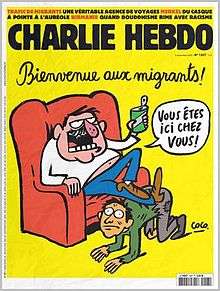
Daniel Schneidermann argues that the 2015 attack raised the profile of the paper internationally with non-Francophone audiences, meaning that only parts of the paper are selectively translated into English, making it easy to misrepresent the editorial stance of the publication and the purpose of provocative work.[93] Nadine Morano was offended at being drawn as a baby with down syndrome after making remarks supporting the National Front.[94]
One year after the attack, the weekly featured a caricature of Yahweh with a Kalashnikov rifle. The Vatican and Jewish groups said they were offended,[95][96] and the Associated Press censored images of the cover.[97][98]
The 14 September 2015 edition's cover cartoon by Coco depicted a migrant being maltreated by a man who proclaims "welcome to refugees" - in order to parody European claims about compassion.[99] Riss wrote an editorial on the European migrant crisis, arguing that it was hypocritical for Hungarian politicians to declare themselves compassionate because of their Christian beliefs, but at the same time reject migrants from Syria. Riss parodied anti-immigrant attitudes by featuring a cartoon with a caricature of Jesus walking on water next to a drowning Muslim boy, with the caption "this is how we know Europe is Christian". The cartoons were widely seen as gallows humour in France, but prompted another wave of controversy abroad.[100] That issue also included a caricature of the dead body of Syrian Kurdish refugee child Alan Kurdi next to a McDonald's sign with the caption, "So close to his goal."[101] In response to criticism, cartoonist Corinne Rey said that she was criticising the consumerist society that was being sold to migrants like a dream.[102]
Following the crash of Metrojet Flight 9268, which killed 224 civilians and was seen as a probable terrorist attack, Charlie Hebdo published cartoons which were widely perceived as mocking the victims of the tragedy. One of the cartoons showed pieces of the plane falling on an Islamic State (ISIS) fighter with the caption: "Russia's air force intensifies its bombing." A spokesman for Vladimir Putin called the artwork "sacrilege", and members of the State Duma called for the magazine to be banned as extremist literature and demanded an apology from France.[103]
After the New Year's Eve sexual assaults in Germany, a January 2016 edition included a cartoon by Riss about the dead child Alan Kurdi, reflecting fickle sentiment towards refugees by including a caption questioning whether the boy would have grown up to be an "ass groper in Germany".[104][105][106][107]
On 2 September 2016, following the August 2016 Central Italy earthquake, which caused 294 deaths, the French magazine published a cartoon in which the earthquake victims are depicted as pasta dishes, under the title "Séisme à l'italienne".[108] The reaction of Italians was unleashed on social networks so that, on the official Facebook page of the magazine, the cartoonist Coco pointed out with another cartoon:
Italians ... is not Charlie Hebdo that builds your houses, is the Mafia![109]
However, even this has sparked controversy in a large number of Italians on social networks. Meanwhile, the French ambassador in Rome, in a statement, pointed out that the French Government's position on the Italian earthquake is not that expressed by Charlie Hebdo.[110]
Staff
- Gérard Biard, editor
- Sylvie Coma
- Riss, cartoonist, managing editor, director of publication
- Catherine Meurisse, cartoonist
- Coco, cartoonist
- Willem, cartoonist
- Walter Foolz, cartoonist
- Babouse, cartoonist
- Antonio Fischetti, journalist
- Zineb El Rhazoui, journalist
- Philippe Lançon, critic
- Fabrice Nicolino, journalist
- Sigolène Vinson, journalist
- Laurent Léger, journalist
- Jean-Baptiste Thoret, critic
- Mathieu Madénian, columnist
- Simon Fieschi, webmaster
- Richard Malka, lawyer
- Eric Portheault, finance manager
See also
- Le Canard enchaîné, a satirical weekly French newspaper
- Republican marches
- Private Eye, a satirical fortnightly English magazine
References
Notes
- 1 2 McNab 2006, p. 26: "Georges Bernier, the real name of 'Professor Choron', [… was] cofounder and director of the satirical magazine Hara Kiri, whose title was changed (to circumvent a ban, it seems!) to Charlie Hebdo in 1970."
- ↑ "Charlie Hebdo: first cover since terror attack depicts prophet Muhammad". The Guardian. 13 January 2015. Retrieved 13 January 2015.
- ↑ "2 vendors arrested for selling newspaper with Hebdo cartoon" (Mid-Day.com). Mid Day. Retrieved 5 February 2015.
- ↑ "The Charlie Hebdo Conspiracy Too Crazy Even for Alex Jones". www.thedailybeast.com. Retrieved 20 January 2015.
- ↑ "REFILE-No rules, no regrets for French cartoonists in Mohammad storm". Reuters.
- ↑ [-http://www.bbc.com/news/world-europe-15551998 "Charlie Hebdo and its place in French journalism"] Check
|url=value (help). BBC. Retrieved 20 January 2015. - ↑ "Charlie Hebdo: Gun attack on French magazine kills 12". BBC. Retrieved 20 January 2015.
- ↑ Charb. "Non, "Charlie Hebdo" n'est pas raciste !". Le Monde. Retrieved 4 March 2014.
- ↑ "Charlie Hebdo: They're Not Racist Just Because You're Offended". Huffingtonpost. Retrieved 22 January 2015.
- ↑ Megan Gibson. "The Provocative History of French Weekly Newspaper Charlie Hebdo". Time. Retrieved 11 January 2015.
- 1 2 Lemonnier 2008, p. 50.
- ↑ Sherwin, Adam (16 January 2015). "What is Charlie Hebdo? A magazine banned and resurrected but always in the grand tradition of Gallic satire". The Independent. Retrieved 16 January 2015.
- ↑ Cavanna et "les cons", Le Monde, 14 February 2014
- ↑ Quelle est l’origine du nom Charlie Hebdo ?, Lyon Capitale, 12 janvier 2015
- ↑ Pourquoi Charlie Hebdo s'appelle Charlie Hebdo, Direct Matin, 8 January 2015
- ↑ Wolinski L'ex-rédacteur en chef de «Charlie mensuel», se souvient de «Peanuts» «Ça serait bien de renouer avec ce genre de BD», Libération, 4 février 2000
- ↑ Abbruzzese, Jason. "What is Charlie Hebdo? Behind the covers of the French satirical magazine targeted in deadly attack". Mashable.com. Retrieved 16 February 2015.
- ↑ Antoine Guiral, "Les 173 704 signatures de Charlie Hebdo" in Libération, 12 September 1996.
- ↑ L’opinion du patron, Les Mots Sont Importants, 4 March 2006.
- ↑ Chabert, Chrystel. "Philippe Val : "Il ne faut pas que mes amis soient morts pour rien"". francetvinfo.fr. France TV Info. Retrieved 16 February 2015.
- ↑ Charlie Hebdo doit verser 90 000 euros à Siné, Libération, 17 December 2012.
- ↑ "Cabu reste actionnaire de Charlie Hebdo". Charlie Enchaîné. Retrieved 18 January 2015.
- ↑ Adam Withnall; John Lichfield (7 January 2015). "Charlie Hebdo shooting: At least 12 killed as shots fired at satirical magazine's Paris office". The Independent. Paris. Retrieved 11 January 2015.
- ↑ Susman, Tina (5 May 2015). "At PEN Gala, Charlie Hebdo editor calls for free expression and debate". Los Angeles Times. Retrieved 22 November 2015.
- ↑ Janssen, Esther, "Limits to Expression on Religion in France" (8 March 2012). Agama & Religiusitas di Eropa, Journal of European Studies, Vol. V, No. 1, pp. 22–45, 2009. Produced in cooperation between the University of Indonesia and the Delegation of the European Commission.; Amsterdam Law School Research Paper No. 2012–45; Institute for Information Law Research Paper No. 2012–39. Available at SSRN: SSRN
- ↑ Leprince, Chloé. "L'Affaire Siné". The Guardian. Retrieved 9 May 2015.
- ↑ "Le Tribunal de Grande Instance donne raison à Siné contre Charlie Hebdo," ActuaBD (11 December 2010).
- ↑ "Culte Musulman et Islam de France". CFCM TV. 22 March 2007. Retrieved 21 December 2011.
- ↑ "Writers' statement on cartoons (1 March 2006)". BBC News. 1 March 2006. Retrieved 21 December 2011.
- ↑ Heneghan, Tom (2 February 2007). "Cartoon row goes to French court". IOL.
- ↑ "Caricatures : Le soutien de Sarkozy à Charlie Hebdo fâche le CFCM". TF1 News. 15 December 2011. Retrieved 21 December 2011.
- ↑ "Charlie Hebdo: Sarkozy accusé de politiser le procès". L'Express. Retrieved 21 December 2011.
- ↑ "French cartoons editor acquitted". BBC. 22 March 2007.
- ↑ "French Satirical Newspaper 'Charlie Hebdo' Wins Second Trial Over Controversial Cartoon Ban Request". Newswire.
- ↑ Schofield, Hugh. "Charlie Hebdo and its place in French journalism." BBC. 3 November 2011.
- 1 2 James Boxel (2 November 2011). "Firebomb attack on satirical French magazine". Financial Times. Retrieved 19 September 2012.
- ↑ "Attack on French satirical paper Charlie Hebdo (2 November 2011)". BBC. 2 November 2011. Retrieved 21 December 2011.
- ↑ "Satirical French magazine names 'Muhammad' as editor". BBC News. 1 November 2011. Retrieved 19 January 2015.
- ↑ Gardiner, Bo (18 January 2015). "A closer look at "Sharia Hebdo," for which Charlie Hebdo was firebombed in 2011".
- ↑ "French paper reprints Mohammad cartoon after fire-bomb". Reuters. 3 November 2011. Retrieved 19 January 2015.
- ↑ Ganley, Elaine (2 November 2011). "Fire at French newspaper after Muhammad issue". Boston.com. Associated Press. Retrieved 16 February 2015.
- ↑ Peter Worthington (9 November 2011). "Extremists hurt non-militant Muslims the most". Toronto Sun. QMI.
- ↑ "Charlie Hebdo publie des caricatures de Mahomet". BMFTV (French) Retrieved 19 September 2012.
- 1 2 Vinocur, Nicholas (19 September 2012). "Magazine's nude Mohammad cartoons prompt France to shut embassies, schools in 20 countries". National Post. Reuters. Retrieved 19 September 2012.
- ↑ Samuel, Henry (19 September 2012). "France to close schools and embassies fearing Mohammed cartoon reaction". The Telegraph. Retrieved 20 September 2012.
- ↑ Khazan, Olga (19 September 2012). "Charlie Hebdo cartoons spark debate over free speech and Islamophobia". The Washington Post. Retrieved 19 September 2012.
- ↑ Keller, Greg; Hinnant, Lori (19 September 2012). "Charlie Charlie Hebdo Mohammed Cartoons: France Ups Embassy Security After Prophet Cartoons". The Huffington Post. Retrieved 19 September 2012.
- ↑ Clark, Nicola (19 September 2012). "French Magazine Publishes Cartoons Mocking Muhammad". The New York Times. Retrieved 19 September 2012.
- ↑ "Press Briefing by Press Secretary Jay Carney, 19 September 2012". The White House.
- ↑ "French leaders sound alarm over planned Mohammad cartoons". Reuters. 18 September 2012. Retrieved 18 September 2012.
- ↑ Stefan Simons (20 September 2012). "'Charlie Hebdo' Editor in Chief: 'A Drawing Has Never Killed Anyone'". Der Spiegel.
- 1 2 Bremner, Charles (7 January 2015). "Islamists kill 12 in attack on French satirical magazine Charlie Hebdo". The Times.
- ↑ "Attentat contre " Charlie Hebdo " : Charb, Cabu, Wolinski et les autres, assassinés dans leur rédaction". Le Monde (in French).
- ↑ "Deadly attack on office of French magazine Charlie Hebdo". BBC News.
- ↑ "Charlie Hebdo attack: What we know so far", BBC News, 8 January 2015.
- ↑ "EN DIRECT. Massacre chez "Charlie Hebdo" : 12 morts, dont Charb et Cabu". Le Point.fr (in French).
- ↑ "Les dessinateurs Charb et Cabu seraient morts". L'Essentiel (in French). France. 7 January 2015. Retrieved 7 January 2015.
- ↑ Conal Urquhart. "Paris Police Say 12 Dead After Shooting at Charlie Hebdo". Time.
Witnesses said that the gunmen had called out the names of individual from the magazine. French media report that Charb, the Charlie Hebdo cartoonist who was on al-Qaeda's most wanted list in 2013, was seriously injured.
- ↑ Victoria Ward. "Murdered Charlie Hebdo cartoonist was on al Qaeda wanted list". The Telegraph.
- ↑ "The Globe in Paris: Police identify three suspects". The Globe and Mail.
- ↑ Adam Withnall, John Lichfield, "Charlie Hebdo shooting: At least 12 killed as shots fired at satirical magazine's Paris office", The Independent, 7 January 2015.
- ↑ Higgins, Andrew; de la Baume, Maïa (8 January 2015). "Two Brothers Suspected in Killings Were Known to French Intelligence Services". The New York Times. Retrieved 8 January 2015.
- ↑ "Paris shooting: Female police officer dead following assault rifle attack morning after Charlie Hebdo killings". The Independent. Retrieved 9 January 2015.
- ↑ "Un commando organisé". Libération. Retrieved 8 January 2015.
- ↑ "Paris Attack Suspect Dead, Two in Custody, U.S. Officials Say". NBC News. Retrieved 8 January 2015.
- ↑ "France, Islam, terrorism and the challenges of integration: Research roundup". JournalistsResource.org, retrieved 23 January 2015.
- ↑ "Charlie Hebdo will come out next week, despite bloodbath". The Times of India. 8 January 2015.
- ↑ "Charlie Hebdo Attack: Magazine to publish next week". BBC News. 8 January 2015. Retrieved 9 January 2015.
- ↑ "Defiant Charlie Hebdo depicts Prophet Muhammad on cover". BBC News. 13 January 2015. Retrieved 13 January 2015.
- ↑ "Charlie Hebdo Attack: Magazine to publish next week". BBC News. 8 January 2015. Retrieved 9 January 2015.
- ↑ "Charlie Hebdo attack: Print run for new issue expanded". BBC News. 14 January 2015. Retrieved 14 January 2014.
- ↑ "Charlie Hebdo: Pellerin veut débloquer un million d'euros". Le Figaro (in French). 8 January 2015. Retrieved 9 January 2015.
- ↑ Russell Brandom (8 January 2015). "Charlie Hebdo will publish one million copies next week". The Verge.
- ↑ Jon Stone (8 January 2015). "French media raises €500,000 to keep satirical magazine Charlie Hebdo open". The Independent.
- ↑ Mcphate, Mike; Mackey, Robert (8 January 2015). "Updates on the 2nd Day of Search for Suspects in Charlie Hebdo Shooting". The New York Times.
- ↑ "How I created the Charlie Hebdo magazine cover: cartoonist Luz's statement in full". The Telegraph. 13 January 2015.
- ↑ "image". Enis Yavuz. Archived from the original on 9 January 2015. Retrieved 8 January 2015.
- ↑ "#JeSuisCharlie creator: Phrase cannot be a trademark". BBC News. 14 January 2015. Retrieved 14 January 2015.
- ↑ "Charlie Hedbo". 7 January 2015.
- ↑ Richard Booth (7 January 2015). "'Je suis Charlie' trends as people refuse to be silenced by Charlie Hebdo gunmen". Daily Mirror.
- ↑ Isabelle Hanne. "Charlie" s'installe à "Libé" : "Bon, on fait le journal ?". Libération (in French). Retrieved 9 January 2015.
- ↑ "Paris Terror Suspects Killed in Twin French Police Raids". Bloomberg. 9 January 2014. Retrieved 11 January 2015.
- ↑ Le Point, magazine. "Luz: le soutien à Charlie Hebdo est à "contre-sens" de ses dessins". Le Point.fr.
- ↑ Le Point, magazine. "Willem : "Nous vomissons sur ceux qui, subitement, disent être nos amis"". Le Point.fr.
- ↑ "Five killed in second day of Charlie Hebdo protests in Niger". Reuters. Retrieved 18 January 2015.
- 1 2 Emma Graham-Harrison. "Niger rioters torch churches and attack French firms in Charlie Hebdo protest". The Guardian. Retrieved 18 January 2015.
- ↑ "'Love to Prophet Mohammed': Crowds protest Charlie Hebdo cartoons in Chechnya". RT. 19 January 2015. Retrieved 19 January 2015.
- ↑ Davidzon, Vladislav (January 23, 2015). "Why Russia is No Place to Be Charlie". Tablet. Retrieved January 4, 2016.
- ↑ Richards, Victoria (11 March 2015). "Charlie Hebdo: Murdered staff given 'Islamophobe of the Year' award". The Independent. Retrieved 11 March 2015.
- ↑ "Charlie Hebdo staff awarded Secularist of the Year prize for their response to Paris attacks". NSS. 28 March 2015. Retrieved 28 March 2015.
- ↑ Picquard, Alexandre. "" La vie à "Charlie" n'a jamais été un fleuve tranquille "". Le Monde. Retrieved 21 July 2015.
- ↑ "" Charlie Hebdo " devient la première " entreprise solidaire de presse "". Le Monde. Retrieved 21 July 2015.
- ↑ "Charlie Hebdo de nouveau victime de son paradoxal succès". Slate.fr (in French). 14 Jan 2016.
- ↑ Elise Lambert. ""Charlie Hebdo" : "On se moque de Nadine Morano, pas des handicapés", explique la dessinatrice Coco". francetv info.
- ↑ "Vatican newspaper denounces 'woeful' Charlie Hebdo cover". Yahoo News. 6 January 2016. Retrieved 26 March 2016.
- ↑ "Chief Rabbi Ephraim Mirvis says Charlie Hebdo 'God' cartoon is insulting to believers". thejc.com. Retrieved 26 March 2016.
- ↑ Erik Wemple (7 January 2016). "AP removes images of God-as-terrorist Charlie Hebdo cover". Washington Post. Retrieved 26 March 2016.
- ↑ "Associated Press Self-Censors Anniversary Charlie Hebdo Cover". Reason.com. Retrieved 26 March 2016.
- ↑ "Charlie Hebdo Mocks Europe's Response to Migrant Crisis With Cartoons of Dead Syrian Boy". New York Times.
- ↑ "Les dessins de "Charlie Hebdo" sur la mort du petit Aylan scandalisent les internautes à l'étranger". Le Huffington Post (in French). 15 September 2015.
- ↑ "Charlie Hebdo Cartoon Depicts Drowned Toddler Aylan Kurdi as Future Sexual Harasser". Newsweek. Retrieved 2016-01-14.
- ↑ Mackey, Robert (2015-09-15). "Charlie Hebdo Mocks Europe's Response to Migrant Crisis With Cartoons of Dead Syrian Boy". The New York Times. ISSN 0362-4331. Retrieved 2016-01-14.
- ↑ "Russia hits out at Charlie Hebdo over crash cartoon". BBC News.
- ↑ Jessica Brown (14 January 2016). "The Charlie Hebdo cartoon about Aylan Kurdi and sex attackers is one of its most powerful". The Independent.
- ↑ "Charlie Hebdo cartoon depicts grown-up Aylan Kurdi as 'ass groper in Germany'". The Independent. Retrieved 2016-01-14.
- ↑ "Charlie Hebdo cartoon depicting drowned child Alan Kurdi sparks racism debate". The Guardian. 2016-01-14. ISSN 0261-3077. Retrieved 2016-01-14.
- ↑ "Charlie Hebdo backlash over 'racist' Alan Kurdi cartoon - BBC News". BBC News. Retrieved 2016-01-14.
- ↑ "Charlie Hebdo draws Italian anger with cartoon portraying earthquake victims as pasta". The Telegraph. Retrieved 5 September 2016.
- ↑ https://www.facebook.com/106626879360459/photos/a.106706332685847.10430.106626879360459/1236792179677251/?type=3&theater
- ↑ "French embassy disowns Charlie Hebdo cartoons". ANSA. Retrieved 5 September 2016.
Bibliography
- Lemonnier, Bertrand (2008). "L'entrée en dérision". Vingtième Siècle: Revue d'histoire. 98: 43–55. JSTOR 20475319.
- McNab, James P. (2006). "Bloc-notes Culturel: l'année 2005". The French Review. 80 (1): 16–29. JSTOR 25480584.
Further reading
- Egen, Jean (1976). La Bande à Charlie. Stock. ISBN 9782234005532.
External links
| Wikimedia Commons has media related to Charlie Hebdo. |
- Official website (French)
- "Un historique d'Hara-Kiri/Charlie Hebdo" (in French). Archived from the original on 24 March 2007.